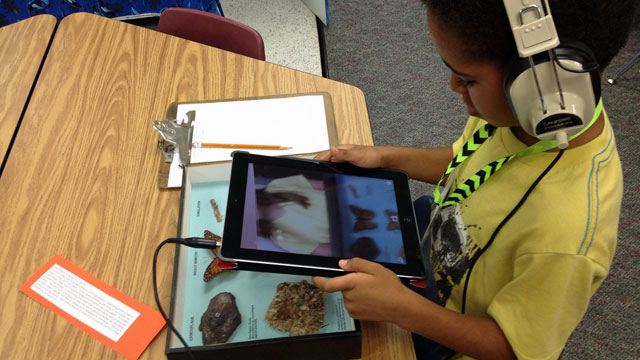Granting students the freedom to inquire and explore makes them the investigators of life’s mysteries. In the process, they are sharpening their all-important critical and creative thinking skills. Technology offers fantastic opportunities for the application of critical thinking skills toward an understanding of real-world questions and answers. It can be used to gather information about the world around us so that we can investigate real-world questions and test their answers. That’s the focus of this chapter. You find numerous apps that deliver content about botany or algebra, but I want to focus on how you can use technology to have students experience that knowledge from the inside out.
This chapter looks at tools that can be used with the iPad to help you investigate phenomena and collect data. After you collect that data, you look at tools that help analyze the information and present conclusions. You focus less on apps and instead discuss the “application” of mobile technology within a more inquiry-based approach to science and math education. It should be fun!
Whether it’s geometry, physics, or chemistry, scientific method starts with research, discussion, and the development of a hypothesis about the phenomenon being examined. A substantial amount of space in this book is devoted to research, communication, organization, and sharing of information — all important elements in the research and development stage. You start by jumping to the next step: using the iPad for investigating and gathering data for analysis.
DEMONSTRATING MATHEMATICAL PROOFS
Submitted by: Dr. Randy Yerrick, professor of science education, State University of New York at Buffalo
Grade level: 8th- to 12th-grade math
Objectives: Have students demonstrate knowledge of mathematical proofs.
Apps/tools: Keynote, Explain Everything app
Following the lesson where math teachers demonstrate the construction of an algebraic or geometric proof, students are given the opportunity to create their own. Using media-based presentations and audio recordings of their own voices, students create and share a narrated slide-show presentation.
Keynote is Apple’s presentation app that enables students to build a slidebased presentation with text and media, which they then present live in front of an audience. The Explain Everything app (detailed in Chapter 17) enables students to build and record a series of narrated slides with picture, text, and media content that explains and demonstrates a concept to an audience. Essentially, once students put the slides in the order they choose, they tap Record and step through their slides, explaining, highlighting with color, and accentuating with the laser pointer feature. The Record function also enables students to pause or to rerecord their presentation so that they can practice before presenting it to the class. Explain Everything also includes members’ libraries and upload links to such social media sharing sites as Dropbox and Facebook, making student sharing of work easy and manageable.
Students were given the option of using the preceding apps to explain some of the data that can be retrieved from scientific agencies such as the U.S. Geological Survey (USGS), National Aeronautics and Space Administration (NASA), and the National Oceanic and Atmospheric Administration (NOAA). Students used the latitude and longitude of approaching hurricanes to learn Cartesian coordinates and plot them. For example, one student provided an explanation of the calculated arrival time of a tsunami across the Pacific Ocean from an image acquired from the USGS. This is also a scenario in which students can use apps such as GarageBand or iMovie to collate specific photos they gather into a podcast or movie and explain what they know or how they apply the concepts to examples in the real world.
EXPLORING CELESTIAL MYSTERIES
Submitted by: Dr. Randy Yerrick, professor of science education, State University of New York at Buffalo
Grade level: 4th- to 12th-grade astronomy
Objectives: Navigate the sky for recognizable celestial objects; identify and name constellations, stars, galaxies, and planets.
Apps/tools: iPad 2 (or higher), iOS 5.1 (or higher), Star Walk app
Some of the best science apps created for the iPad are those geared toward the teaching of astronomy. One benefit of these apps is the integration with the built-in accelerometer and GPS information systems that enables users to simply point to the sky to obtain vast updated information about where they are looking. Celestial navigation is made simple through the interactive interfaces that allow the user to turn on and off the available layers of information when pointing at the night sky.
Teaching with the Star Walk app can be as easy as taking an independent evening stroll with the self-lit app in hand and noting the relative positions of the objects in the sky. At the same time, this app adds a robust environment to explore important questions such as:
• Does the sun really rise in the east? Does that change?
• Where do all the planets appear in the sky? How can you tell a planet
from a star or galaxy?
• Can people in the Southern Hemisphere see the same stars as people in
the Northern, Eastern, or Western hemispheres?
• Where do stars go during the day?
The power of this app can be seen in a very simple activity for children up through adulthood. Ask students, “How many planets are there? More important, how do you know?” Have students point out any objects in the sky that they think are planets, and before they use Sky Walk, ask them to point to any they can see. Ask them to draw where those objects would appear at night, and explain what they would look like.


